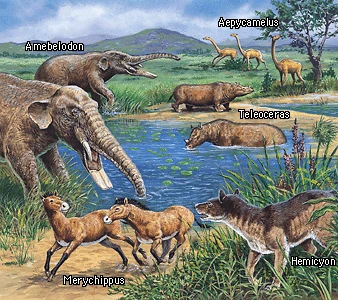
The Cenozoic Era (sen-oh-ZOH-ik; sometimes Caenozoic Era in the United Kingdom) meaning "new life" (Greek: kainos = new + zoe = life) is the most recent of the three classic geological eras. It covers the 65.5 million years since the Cretaceous-Tertiary extinction event at the end of the Cretaceous that marked the demise of the last dinosaurs and the end of the Mesozoic Era. The Cenozoic era is ongoing.
The Cenozoic is divided into two periods, the Paleogene and Neogene, and they are in turn divided into epochs. The Palaeogene consists of the Paleocene, Eocene, and Oligocene epochs, and the Neogene consists of the Miocene, Pliocene, Pleistocene, and Holocene epochs, the last of which is ongoing. Historically, the Cenozoic has been divided into periods (or sub-eras) named the Tertiary (Paleocene to Pliocene) and Quaternary (Pleistocene and Holocene), although most geologists no longer recognize them.
Life in the Cenozoic Era[]
The Cenozoic is the age of mammal. During the Cenozoic, mammals diverged from a few small, simple, generalized forms into a diverse collection of terrestrial, marine, and flying animals. The Cenozoic is just as much the age of savannas, or the age of co-dependent flowering plants and insects. Birds also evolved substantially in the Cenozoic.
Geologically, the Cenozoic is the era when continents moved into their current positions. Australia-New Guinea split from Gondwana to drift north and, eventually, abut South-east Asia; Antarctica moved into its current position over the South Pole; the Atlantic Ocean widened and, later in the era, South America became attached to North America.
See also[]
- Geologic Time Scale
References and further reading[]
- British Caenozoic Fossils, 1975, The Natural History Museum, London.
Template:Phanerozoic Footer Template:Cenozoic Footer